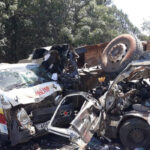Embarking on a safari in Kenya’s breathtaking landscapes, from the Maasai Mara to Tsavo National Park, is an adventure like no other. However, the rugged terrains and unpredictable conditions demand preparedness. A common driving exam question in Kenya asks, “What are the four important tools you have to carry when driving for a safari?” The correct options—car jack, spare wheel, spotlight, and fire extinguisher—are critical for safety and compliance with Kenyan road regulations. This article breaks down why these tools are essential, ensuring drivers are ready for a seamless safari experience in 2025.
Why These Tools Matter for Safari Driving
Kenya’s safari routes often involve remote, uneven roads where breakdowns or emergencies can occur without immediate access to help. According to the National Transport and Safety Authority (NTSA), carrying specific tools is not only a legal requirement but also a practical necessity for safe driving. These tools—car jack, spare wheel, spotlight, and fire extinguisher—equip drivers to handle common roadside issues, from flat tires to low visibility, ensuring safety for both the driver and passengers. Understanding their purpose is key to passing your driving exam and thriving on Kenya’s adventurous roads.
The Four Must-Have Tools for a Safari
Here’s a detailed look at the four essential tools every driver must carry for a Kenyan safari:
- Car Jack: A car jack is vital for lifting your vehicle to replace a flat tire or perform minor repairs. Kenya’s off-road trails, such as those in Amboseli, are prone to punctures due to sharp rocks or thorns. A sturdy, portable jack ensures you can quickly address such issues without being stranded. The NTSA recommends a hydraulic or scissor jack for most vehicles, emphasizing its inclusion in your emergency kit.
- Spare Wheel: A spare wheel is non-negotiable for safari drives. Flat tires are common on Kenya’s gravel roads, and a spare ensures you can continue your journey without delay. Always check that your spare wheel is in good condition and properly inflated before departure. The Kenya Roads Act mandates carrying a functional spare wheel, as highlighted in NTSA’s 2025 road safety guidelines.
- Spotlight: Navigating Kenya’s national parks at dusk or dawn requires enhanced visibility. A spotlight helps illuminate dark or foggy paths, ensuring safe driving in low-light conditions. It’s particularly useful for spotting wildlife crossing roads, a frequent occurrence in areas like Tsavo. Choose a durable, high-lumen spotlight to comply with NTSA’s safety standards.
- Fire Extinguisher: A fire extinguisher is a critical safety tool for handling potential vehicle fires caused by electrical faults or overheating on long drives. NTSA regulations require all vehicles, especially those used for safaris, to carry a functional fire extinguisher (preferably dry powder or CO2 type). Regular checks ensure it’s operational, safeguarding lives and property.
Practical Tips for Safari Preparedness
Beyond these tools, Kenyan drivers should adopt additional measures for a safe safari. Always inspect your vehicle before departure, ensuring the car jack, spare wheel, spotlight, and fire extinguisher are accessible and functional. Carry a basic toolkit, first aid kit, and sufficient water, as advised by the Automobile Association of Kenya (AA Kenya). Familiarize yourself with your route using updated maps or GPS, and inform someone of your travel plans, especially in remote areas. These steps align with NTSA’s 2025 campaign for road safety awareness.
Carrying a car jack, spare wheel, spotlight, and fire extinguisher is not just about passing a driving exam—it’s about ensuring safety on Kenya’s thrilling yet challenging safari routes. These tools empower drivers to handle emergencies confidently, from flat tires in Samburu to low visibility in Aberdare. By staying prepared and adhering to NTSA guidelines, you can enjoy Kenya’s stunning landscapes worry-free. Pack these essentials, plan ahead, and make your 2025 safari adventure unforgettable.





